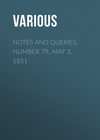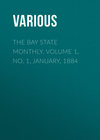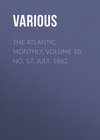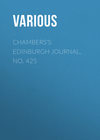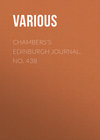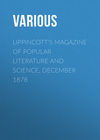Kitabı oku: «Notes and Queries, Number 79, May 3, 1851», sayfa 4
Blowen.
Replies
THE FAMILY OF THE TRADESCANTS
(Vol. ii., pp. 119. 286.)
The family of the Tradescants is involved in considerable obscurity, and the period of the arrival of the first of that name in England is not, for a certainty, known. There were, it seems, three of the Tradescants at one time in this country—grandfather, father, and son. John Tradescant (or Tradeskin, as he was generally called by his contemporaries) the elder was, according to Anthony Wood, a Fleming or a Dutchman. He probably came to England about the latter end of the reign of Elizabeth, or in the beginning of that of James the First. He is reported to have been a great traveller, and to have previously visited Barbary, Greece, Egypt, and other Eastern countries. Upon his first arrival here he is said to have been successively gardener to the Lord Treasurer Salisbury, Lord Weston, the Duke of Buckingham, and other noblemen of distinction. In these situations he remained until the office of royal gardener was bestowed upon him in 1629.
To John Tradescant the elder, posterity is mainly indebted for the introduction of botany in this kingdom. "He, by great industry, made it manifest that there is scarcely any plant existing in the known world, that will not, with proper care, thrive in our climate." In a visit made by Sir W. Watson and Dr. Mitchell to Tradescant's garden in 1749, an account of which is inserted in the Philosophical Transactions, vol. xlvi. p. 160., it appears that it had been many years totally neglected, and the house belonging to it empty and ruined; but though the garden was quite covered with weeds, there remained among them manifest footsteps of its founder. They found there the Borago latifolia sempervivens of Caspar Bauhine; Polygonatum vulgare latifolium, C.B.; Aristolochia clematitis recta, C.B.; and the Dracontium of Dodoens. There were then remaining two trees of the Arbutus, which from their being so long used to our winters, did not suffer from the severe cold of 1739-40, when most of their kind were killed in England. In the orchard there was a tree of the Rhamnus catharticus, about twenty feet high, and nearly a foot in diameter. There are at present no traces of this garden remaining.
In the Ashmolean Library is preserved (No. 1461.) a folio manuscript (probably in the handwriting of the elder Tradescant) which purports to be "The Tradescants' Orchard, illustrated in sixty-five coloured drawings of fruits, exhibiting various kinds of the apple, cherry, damson, date, gooseberry, peares, peaches, plums, nectarines, grape, Hasell-nutt, quince, strawberry, with the times of their ripening."
Old John Tradescant died in the year 1652, at which period he was probably far advanced in years, leaving behind him a son (also of the same name) who seems to have inherited his father's talents and enthusiasm. There is a tradition that John Tradescant the younger entered himself on board a privateer going against the Algerines, that he might have an opportunity of bringing apricot-trees from that country. He is known to have taken a voyage to Virginia, whence he returned with many new plants. The two Tradescants were the means of introducing a variety of curious species into this kingdom, several of which bore their name. Tradescants' Spiderwort and Aster are well known to this day, and Linnæus has immortalised them among the botanists by making a new genus under their names of the Spiderwort, which had been before called Ephemeron.
When the elder Tradescant first settled in England, he formed a curious collection of natural history, coins, medals, and a great variety of "uncommon rarities." A catalogue of them was published in 12mo. in the year 1656, by his son, under the name of Museum Tradescantianum; to which are prefixed portraits, both of the father and son, by Hollar. This Museum or "Ark," as it was termed, was frequently visited by persons of rank, who became benefactors thereto; among these were Charles the First, Henrietta Maria (his queen), Archbishop Laud, George Duke of Buckingham, Robert and William Cecil, Earls of Salisbury, and many other persons of distinction: among them also appears the philosophic John Evelyn, who in his Diary has the following notice:
"Sept. 17, 1657, I went to see Sir Robert Needham, at Lambeth, a relation of mine, and thence to John Tradescant's museum."
"Thus John Tradeskin starves our wondering eyes
By boxing up his new-found rarities."
Ashmole, in his Diary (first published by Charles Burman in 1717), has three significant entries relating to the subject of our notice, which I transcribe verbatim:
"Decem. 12, 1659. Mr. Tredescant and his wife told me they had been long considering upon whom to bestow their closet of curiosities when they died, and at last had resolved to give it unto me.
"April 22, 1662. Mr. John Tredescant died.
"May 30, 1662. This Easter term I preferred a bill in Chancery against Mrs. Tredescant, for the rarities her husband had settled on me."
The success of Ashmole's suit is well known; but the whole transaction reflects anything but honour upon his name. The loss of her husband's treasures probably preyed upon the mind of Mrs. Tradescant; for in the Diary before quoted, under April 4, 1678, Ashmole says:
"My wife told me that Mrs. Tradescant was found drowned in her pond. She was drowned the day before at noon, as appears by some circumstance."
This was the same Hesther Tradescant who erected the Tradescant monument in Lambeth churchyard. She was buried in the vault where her husband and his son John (who "died in his spring") had been formerly laid.
The table monument to the memory of the Tradescants was erected in 1662. The sculptures on the four sides are as follows, viz. on the north, a crocodile, shells, &c., and a view of some Egyptian buildings; on the south, broken columns, Corinthian capitals, &c., supposed to be ruins in Greece, or some Eastern country; on the east, Tradescant's arms, on a bend three fleurs-de-lys, impaling a lion passant; on the west, a hydra, and under it a skull; various figures of trees, &c., in relievo, adorn the four corners of the tomb; over it is placed a handsome tablet of black marble. The monument, by the contribution of some friends to their memory, was in the year 1773 repaired, and (according to Sir John Hawkins) the following lines, "formerly intended for an epitaph, inserted thereon." Other authorities say that they were merely restored.
"Know, stranger, ere thou pass beneath this stone,
Lye John Tradescant, grandsire, father, son;
The last dy'd in his spring; the other two
Liv'd till they had travell'd Art and Nature through,
As by their choice collections may appear,
Of what is rare, in land, in sea, in air;
Whilst they (as Homer's Iliad in a nut)
A world of wonders in one closet shut;
These famous antiquarians that had been
Both Gardeners to the Rose and Lily Queen,
Transplanted now themselves, sleep here; and when
Angels shall with their trumpets waken men,
And fire shall purge the world, these hence shall rise,
And change this garden for a Paradise."
A number of important errors concerning this once celebrated family have been made by different writers. Sir John Hawkins, in a note to his edition of Walton's Angler (edit. 1792, p. 24.), says:
"There were, it seems, three of the Tradescants, grandfather, father, and son: the son is the person here meant: the two former were gardeners to Queen Elizabeth, and the latter to King Charles I."
The epitaph above quoted satisfactorily proves, I think, that the Tradescants were never gardeners to the maiden Queen. "The rose and lily queen" was certainly Henrietta Maria, the queen of Charles the First. I have now before me (from the cabinet of a friend) a small silver medal struck to commemorate the marriage of Charles the First. It has on the obverse the busts of Charles and Henrietta, the sun shining from the clouds above them: the inscription is CH: MAG: ET: HEN: MA: BRIT: REX: ET: REG. The reverse contains in the field, Cupid mixing lilies with roses; the legend being FVNDIT: AMOR: LILIA: MIXTA: ROSIS. In the exergue is the date 1625. The Tradescant mentioned by Walton in 1653 was the second of that name, not the son, as stated by Sir John Hawkins.
The editor of the last edition of Evelyn's Diary (vol. ii. p. 414.) says, speaking of the Tradescants:
"They were all eminent gardeners, travellers, and collectors of curiosities. The two first came into this country in the reign of James I., and the second and third were employed in the Royal Gardens by Charles I."
Here is a positive statement that the elder Tradescant and his son came into England in the reign of James I. But there is no proof of this given. It is merely the writer's assertion. At the end of the same note, speaking of Tradescant's Ark, the editor observes:
"It formed the foundation of the Ashmolean Museum at Oxford, and a catalogue of its contents was printed by the youngest John Tradescant in 1656, with the title of Museum Tradescantianum. He died in 1652."
It was not the youngest John Tradescant that died in 1652, but the oldest, the grandfather—the first of that name that settled in England.
The following is a list of the portraits of the Tradescant family now in the Ashmolean Museum; both father and son are in these portraits called Sir John, though it does not appear that either of them was ever knighted. Mr. Black, in his excellent catalogue of the Ashmolean Library, also calls the elder Tradescant Sir John. (See p. 1266.)
1. Sir John Tradescant, sen., three-quarter size, ornamented with fruit, flowers, and garden roots.
2. The same, after his decease.
3. The same, a small three-quarter piece, in water colours.
4. A large painting of his wife, son, and daughter, quarter-length.
5. Sir John Tradescant, junior, in his garden, with a spade in his hand, half-length.
6. The same with his wife, half-length.
7. The same, with his friend Zythepsa of Lambeth, a collection of shells, &c. upon a table before them.
8. A large quarter piece inscribed Sir John Tradescant's second wife and son.
Granger says he saw a picture at a gentleman's house in Wiltshire, which was not unlike that of the deceased Tradescant, and the inscription was applicable to it:
"Mortuus haud alio quam quo pater ore quiesti,
Quam facili frueris nunc quoque nocte doces."
I may add, in conclusion, that several beautiful drawings of the Tradescant monument in Lambeth churchyard are preserved in the Pepysian library. These drawings were engraved for the Philosophical Transactions, vol. lxiii. p. 88.; and are printed from the same plates in the Bibliotheca Topographica Britannica, vol. ii.
Edward F. Rimbault.
